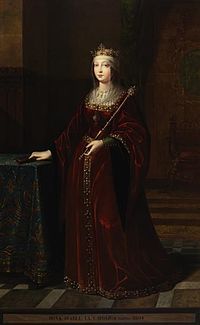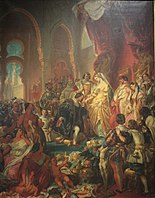Marta I
| Marta I | |||||||||
|---|---|---|---|---|---|---|---|---|---|
| The Conqueror | |||||||||
 Portait of Marta I by Vespasian artist Antonio Fauliano | |||||||||
| Queen of Paretia | |||||||||
| Tenure | 20 July 1541 - 3 November 1552 | ||||||||
| Coronation | 20 July 1541 | ||||||||
| Predecessor | Position Established | ||||||||
| Successor | Cássio of Herança | ||||||||
| Queen of Luzela | |||||||||
| Tenure | 16 May 1519 - 3 November 1552 | ||||||||
| Coronation | 16 May 1519 | ||||||||
| Predecessor | João II | ||||||||
| Successor | Cássio of Herança | ||||||||
| Born | 9 August 1498 | ||||||||
| Died | 23 March 1552 (age 54) | ||||||||
| Spouse | Mateus of Luzela | ||||||||
| Issue | Pio I Infanta Sara Infanta Isabela | ||||||||
| |||||||||
| House | Azulas | ||||||||
| Father | João II | ||||||||
| Mother | Boatriz | ||||||||
| Religion | Solarian Catholic Church | ||||||||
| Military career | |||||||||
| Allegiance | |||||||||
| Years of service | 1516-1552 | ||||||||
| Rank | Condestável | ||||||||
Marta I (Marta Teresa Rosália Boatriz da Azulas da Luzela e Paretia; Born 9 August 1498) was the Queen of Luzela from 1519 to 1551, and later founder and Queen of Paretia from 1541 to 1552. She was born on August 9th 1498 into the House of Azulas, Luzela's ruling family. Her father was king João II and Queen Boatriz the Catholic. She was the family's first born child, she had three other siblings, her brothers Lourenço and Cássio, and her sister Alba.
Early Life

Marta was born Marta Teresa Rosália Boatriz on 9 August 1498 to João II and Boatriz the Catholic, she was the first born. She would grow up with three younger siblings, brothers Lourenço and Cássio, and sister Alba. Her family lived under luxurious conditions in the Violet Fortress in Precea during a period of history where Luzela was making itself a notable power, especially in the Asterias, where under João II the first colonies of Luzela settled in Belmonte.
Marta's mother suffered from dementia during much of her childhood, who had episodes of her condition rather frequently, she was often kept away from public eye during much of her life during her husband and during Marta's rule.
Marta and her siblings were educated a great extent by their father, who, according to the Arquivo Real, told them of the ambition of conquering and uniting the Paretia peninsula. Lourenço died in a combat training accident at 15. They were educated extensively in politics, war stategy, and combat, which according to the Arquivo, were each eventually specialties of the other three siblings. Marta was said to be most talently skilled in politics the most, while her brother was said to be a master battle strategist and commander, and sister an excellent fighter.
In 1514 Marta had her first child to an unknown father, Pio. In 1519 João II would die of old age. And, according to the Decree of Azulas of 1516 by her father, Marta would be given the throne.
Early rule
In 1519 Marta I would be coronated in Precea. In 1520 Marta would marry Mateus of Coroa, but under her father's decree, would keep her house line moving forward. Pan-Paretian throught arose in Paretia during João II's rule. Marta I's goal at the beginning of her rule was to consolidate Luzela as the dominant nation against the rising Esmeira.
The first actions as queen by Marta I would be the creation of the Ordem de Sotiras na Península, a military order designed to expand Luzelese influence in the peninsula. It also took part in keeping out Amendist reformist groups in Luzela from rising, it had begun to gain a small amount of popularity in Paretia. Marta I was a devout Catholic and her kingdom alongside Esmeira and Tosutonia began to subjugate any Amendist movements from appearing in the peninsula.
The order, known shortly as the Ordem Península, was headed by Lucio, Count of Chorto. Part of these efforts by the Ordem Península was to arrest of dozens of Amendist preachers in Luzela, as well as banning of Amendist works in the country.
Another action by Marta I was the expansion of the naval armada of Luzela, although her father had already done a great deal in funding the building of dozens of naval vessels, especially caravels. Marta wanted to focus on modernizing these ships and greatly added even more to the armada, Esmeira had begun to form their own large naval force too, and Marta wanted to keep ahead of them.
Colonial expansion

Marta I would visit the colonies of Luzela only once. But in her early rule she made a great deal of focusing on expanding the country's colonial foothold established by her father, especially in Belmonte, which was not very populated. Luzela wanted to compete with Esmeira and began to send settlers in 1521 to the colonies, beginning the greatly expand the settlements in the area. Marta devided the colonies into captaincies amongst Luzela's nobles, and colonization was mainly given to other outside groups.
The colonization effort in Belmonte was slow and was mainly delt with by local leaders and not much by the Luzelese crown itself. Although Marta I met with colonial leaders, as well as native representatives on multiple occasions, mainly to sort out issues in the colony. The crown also began to sent missionaries to the colonies to get converts in the local population.
The leaders in the colonized continued the slow building of the colonies, the terrain and environment made it difficult for colonial expansion for most of Marta's rule. The colonies began to fully establish trade routes with the home kingdom over time during Marta's rule. Marta was greatly focused on expanding upon her nation's power at home on the peninsula still, and would give even more power to the local leaders of the colonies, including religious orders.
Conquest of Paretia
Moves onto Mausoterra
Marta I had already begun planning for taking over the peninsula for over a decade, her father João II had already had ambitions of doing so, and for Marta the task was handed to her upon his death. João II believed in Pan-paretianism, one of the oldest pan-national movements of it's kind, claiming that a united peninsula would make it easier to keep the influencing forces of the Etrurian states and Gaullica out. This idea was passed down to Marta I and she became a great believer in it. It had levels of support in all the nations of the peninsula, but especially in Luzela.
The land of Mausoterra, was the area between Luzela and Tosutonia. It is today located where the cities of Herança and Mausoleu are. During the 15th century many Luzelese began to settle in these areas alongside the Tosutons, making it around evenly split between the two peoples. Marta's father began to enact offerings for Luzelese to settle in these reaches of the peninsula. The Kingdom of Mausoterra was ruled by Tosutons, and by the 1500s became a minority in the area.
